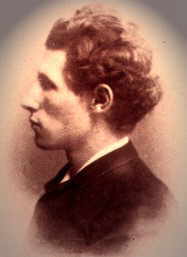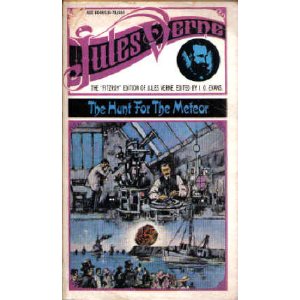A few days gone, I sold my first-ever book in person at Austin’s Rock ‘n Roll Mall, a (mostly) open-air roving market that happens once a month or so. The book, seen below, was the great Jules Verne’s collection of short stories first published as Hier et Demain, or in this Fitzroy English edition, Yesterday and Tomorrow. Being the first book I sold, and a Verne, I thought this would make an interesting work to research for my first post. Turns out, there was a hell of a lot more to this little book than I even thought.
A Few Words on Verne
I personally have a huge love for Verne that began at an early age, when discovering him played a major role in my life-long obsession with science fiction. I remember picking up 20,000 Leagues Under the Sea in order to score Accelerated Reader points in fourth grade (we were encouraged to read through a points system) and being floored by it, leading to me ravenously eating up any other Verne I could find in my school’s library.
It was only later that I found out that my own beginnings with sci-fi were entirely apt, as Verne is considered the first true sci-fi writer and is even called both “The Father of Science Fiction” and “The Inventor of the Future.” Coincidentally, I happened to listen to Professor Michael D.C. Drout’s absolutely excellent lecture on the origins of sci-fi from his “From Here to Infinity” series just days before I sold this book, and in that lecture he refers to Verne as “the first great writer fully in the SF genre,” a sentiment which many critics share.
The story of this particular edition of this particular book is interesting to me for three reasons: the content and history of Yesterday and Tomorrow, the background of the “Fitzroy Editions” and the spectacular cover art by the prolific Jerome Podwil.
The Book’s Background: Death and Controversy
Yesterday and Tomorrow was first published in 1910, five years after Verne’s death at the age of 77 due to diabetes. Though plenty was published in his lifetime, a large amount of Verne’s work was published posthumously, and indeed Yesterday and Tomorrow is one of four Verne short story collections published after his death. In fact, only one collection, Le Docteur Ox (1874) was published while Verne still lived.
When Verne died, he left his works to be published by his son, Michel. Michel and Verne had made up in the years before Verne’s death after decades of drama that mostly centered around Michel’s wild behavior with women. At one point, Jules finally came around to Michel’s would-be wife, an actress he had scandalously eloped with, only to have Michel run off with a 16 year-old soon after his marriage.
Yesterday and Tomorrow was one of the first works put together for publishing by the wild Michel, and it turns out that he did a little more than just collecting the stories. Years after publication, it was discovered that Michel had tampered with, added to and even entirely wrote much of what he published under his father’s name, and Yesterday and Tomorrow is no exception to Michel’s controversial tinkering. Because of this, it’s considered a lesser or even apocryphal work, though that’s also partly to do with the fact that the stories aren’t considered as good as some of Verne’s other writing. (Details on one particular Verne story and how it related to Michel)
The Fitzroy Editions: The British Get in on the Tampering
Even more interesting than the background for the original edition, in my mind, is the story of the 1965 reprinting in the Fitzroy Editions series, which is the book I recently sold. In the late 1950’s, a man with an intense passion for Verne named I. O. Evans decided that he would reacquaint the public with Verne’s lesser-known works by publishing them in his own editions. Evans took his passion and partnered up with a 29 year-old man named Bernard Hanison in London, where Hanison had his offices at 10 Fitzroy Street. The Fitzroy Editions, then, were named after this address, and are just one of many interesting things to happen in the Fitzroy Square area. In addition to being famous for the Verne reprints, this area was also home to both George Bernard Shaw and Virginia Woolf (who lived at the same address at different times), the “Fitzroy Group” artists collective and, later, a famous London advertising agency.
Banison sold his contract to Arco Books in 1959, but Evans stayed as the editor through the history of the Editions. Adding yet another layer of controversy-due-to-tampering to the story of Verne’s works, Evans chopped the living hell out of much of what he published, needing the works to fit a certain page count (no longer than 190 pages) and in order to make them more interesting in his mind. Evans is quoted as saying “I have tried to make the treatment I give each book roughly in proportion to its merits; where I deal with it at length the reader might wish to read it for himself, but where I dismiss it in a few sentences, he might, with a few exceptions, prefer to do the same.” in the preface to Jules Verne and His Work (Arco, 1965). However, in later years, Evans’ tampering is considered cruel and incompetent.
This particular edition of Yesterday and Tomorrow is probably not edited much for length or for the content of the included stories, but, possibly out of a misguided idea that he knew better than the original publishers, Evans removed the story “The Humbug” and added “An Ideal City,” “Ten Hours Hunting,” “Frritt-Flacc,” and “Gil Braltar.” (link to more info on the Fitzroy Editions)
Jerome Podwil: Master of 1960’s Sci-Fi Art
One thing Evans and Co. did do right, however, was to hire the painter Jerome Podwil to illustrate the covers of the Fitzroy Editions. Podwil was already an established cover artist, having worked on first western novels and then moving to sci-fi, and in the 1960’s he was responsible for dozens of sci-fi covers.
Podwil’s style is unique and, in my opinion, immediately engaging, partly due to how he “juxtaposed realistic figures with misty or symbolic backgrounds to evoke a sense of alienness” (from his entry at the Encyclopedia of Science Fiction). During his period of hugely prolific creation in the late 60’s, Podwil’s style showed a lot of range and creativity, even getting a little abstract, and he has even been called a “New Wave” artist (referring to the movement in sci-fi, not in music or film). Podwil’s production fell off in later years, and he even became somewhat of a mystery man due to that, but now he is easily accessible through his still-functioning Myspace page which you can find here.
I love the art work on the Fitzroy Editions, which is gorgeous even down to the font that so boldly display’s the author’s name (and does so larger than the titles by far!). According to the Encyclopedia of Science Fiction, Podwil had to go with a more “representational, even antiquarian style,” though he managed to add in some of his “modern flair,” which I think is easy to see in the finished product. Each Fitzroy Edition had its own color scheme as well, some of which are wonderful, and others not so successful. I particularly like the green on cream of Yesterday and Tomorrow and the purple on white of The Hunt for the Meteor.
So, despite having a few interesting stories and being typically Verne-ian in that it deals with the ancient past, not-too-distant future and the extreme future,the Fitzroy Edition of Yesterday and Tomorrow is probably more interesting for the story of its publication than the actual content, as well as for its excellent art. The cover, in fact, is what caught my eye in the first place, and I think the same could be said of its eventual buyer.
In all, this was a nice little book to come through my possession, and it led me to some very interesting details, as well as giving me a new artist to explore. I’m happy to have had it, and happy to pass it on to a fellow lover of Jules Verne.








